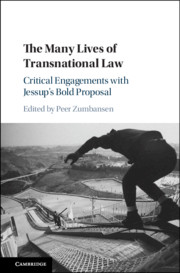Book contents
- Reviews
- The Many Lives of Transnational Law
- The Many Lives of Transnational Law
- Copyright page
- Contents
- Contributors
- Preface and Acknowledgements
- Introduction Transnational Law, with and beyond Jessup
- Part I Transnational Law
- Part II Transnational Law as Regulatory Governance
- 4 Aiding and Abetting in Theorizing the Increasing Softification of the International Normative Order: A Darker Legacy of Jessup’s Transnational Law?
- 5 From International Law to Jessup’s Transnational Law, from Transnational Law to Transnational Legal Orders
- 6 Transnational Law in the Pacific Century
- 7 Transnational Law in Context
- 8 Transnational Law and Adjudication: Domestic, International and Foreign Intersections
- 9 Transnational Law and Global Dispute Resolution
- 10 Conflicts of Law and the Challenge of Transnational Data Flows
- 11 What Lex Sportiva Tells You about Transnational Law
- 12 Family Law
- Part III Transnational Law
- Part IV Conclusion
- Index of Names
- Subject Index
5 - From International Law to Jessup’s Transnational Law, from Transnational Law to Transnational Legal Orders
from Part II - Transnational Law as Regulatory Governance
Published online by Cambridge University Press: 18 March 2020
- Reviews
- The Many Lives of Transnational Law
- The Many Lives of Transnational Law
- Copyright page
- Contents
- Contributors
- Preface and Acknowledgements
- Introduction Transnational Law, with and beyond Jessup
- Part I Transnational Law
- Part II Transnational Law as Regulatory Governance
- 4 Aiding and Abetting in Theorizing the Increasing Softification of the International Normative Order: A Darker Legacy of Jessup’s Transnational Law?
- 5 From International Law to Jessup’s Transnational Law, from Transnational Law to Transnational Legal Orders
- 6 Transnational Law in the Pacific Century
- 7 Transnational Law in Context
- 8 Transnational Law and Adjudication: Domestic, International and Foreign Intersections
- 9 Transnational Law and Global Dispute Resolution
- 10 Conflicts of Law and the Challenge of Transnational Data Flows
- 11 What Lex Sportiva Tells You about Transnational Law
- 12 Family Law
- Part III Transnational Law
- Part IV Conclusion
- Index of Names
- Subject Index
Summary
In Jessup’s 1956 Storrs Lecture he defined transnational law as “all law which regulates actions or events that transcend national frontiers,” which includes public international law, private international law, and “other rules which do not wholly fit into such standard categories.” Considerable recent scholarship on transnational law has focused on that residual category of “other rules” and their “private” character. There has, however, been a revolution in international law itself since 1956, reflected in a proliferation of international institutions, international courts, treaties, and so-called “soft law” technologies of governance. This chapter assesses the role of international law in the creation of what can be viewed as “transnational legal orders” that penetrate and imbue state law, shape social identity, and inform public and private legal practice. International law, this chapter contends, is even a more important shaper of the transnational than in Jessup’s time, and, in turn is shaped by it.
Keywords
- Type
- Chapter
- Information
- The Many Lives of Transnational LawCritical Engagements with Jessup's Bold Proposal, pp. 126 - 152Publisher: Cambridge University PressPrint publication year: 2020



